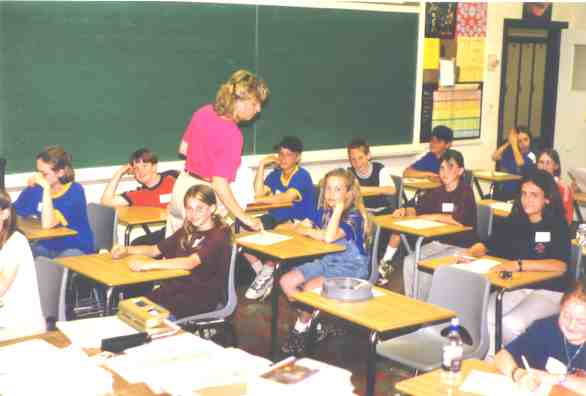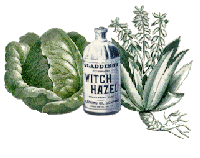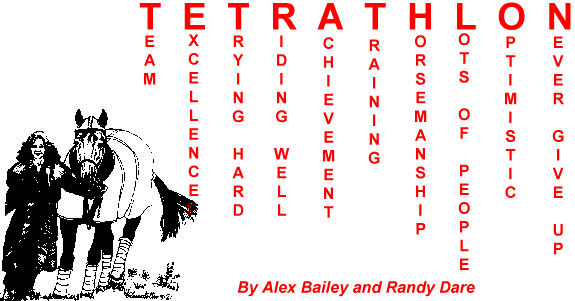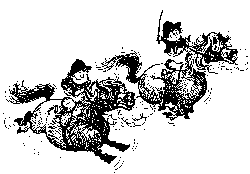

The PONY EXPRESS
Newsletter of the Canadian Pony Club, Western Ontario Region
Editors: Sheila and Patrick Deane, 103 Springfield Crescent, London, Ontario N6K 2W1
Telephone: (519) 473-9144; E-mail: pdeane@julian.uwo.ca
VOLUME 99 NUMBER 2 (MAY 1999)

Okay, ....quiz us (but we 'd rather be riding)!
Regional Quiz
Medway High School, Arva, May 8 1999
Thanks to Betty Elgie for organizing an enjoyable event again this year, and to each club that sent such helpful volunteers and such smart kids.
- The tack sale raised $ 185.00 for the regional travel fund, and hopefully eased for many families the extra expense that always comes with the start of the showing season.
- Linda Agnew (Mount Nemo) wants to locate some of her kids' missing tests. They will be E tests, blue, and numbered 111 to 117. If you picked these up accidentally, Please call Linda at 905-335-8859, or bring them to the regional meeting so Linda can return them to their owners.
|
Club Placings
| |
Individual Placings
|
|
Caledon |
738 points | |
A/B |
Pam Elgie, 1st |
| | | | |
Annie Baird, 2nd | |
Guelph |
676.5 points | |
|
Lindsay Thompson, 3rd |
| | | | |
Katherine Fields, 4th | |
London |
664 points | |
C |
Jennifer Prine, 1st |
| | | | |
Mandy Swallow, 2nd | |
Bluewater |
579 points | |
|
Melanie MacKenzie, 3rd |
| | | | |
Joanna Nairn, 4th | |
High County |
540.5 points | |
D1/D2 |
Lisa Hutchison, 1st |
| | | | |
Theresa Kerr, 2nd | |
Albion |
402 points | |
|
Jaime Anderson, 3rd |
| | | | |
Britt Burechails, 4th | |
Huron Bruce |
393 points | |
D |
Lara Bourke, 1st |
| | | | |
Katie Veinot, 2nd | |
Mill Ridge |
382 points | |
|
Emily Bailey, 3rd |
| | | | |
Jenine Swallow, 4th | |
Niagara |
321 points | |
E |
Heather Agnew, 1st |
| | | | |
Alex Pizans, 2nd | |
Windsor-Essex |
188.5 points | |
|
Steph Visscher, 3rd |
| | | | |
Olivia Molenda, 4th | |
Mount Nemo |
185.5 points | | |
| | |
For complete Quiz results, click here
Website
Western Ontario Region, through the agency of Crawford Dales (Mr. Pony Club), operates a website. This newsletter is one of the many things posted on that website, and any members who would like to receive their copy of the newsletter through the website can send Crawford (jcdales@cogeco.ca) their e-mail address. If members discover any great equine websites, be sure to send them in, and we'll post them here in this newsletter for the education and enjoyment of other members in the region

Western Ontario Region web site:
http://www.CanadianPonyClub.org/WesternOntario
The Ontario Ministry of Agriculture, Food and Rural Affairs:
http://www.gov.on.ca/omafra/english/livestock/horse
The Ontario Association of Equine Practitioners.
http://www.uoguelph.ca/research/equine
A fun one with over 300 quotes referring to horses:
http://www.horses.co.uk/horses/quotes.cgi
|
Guelph Mini-Meet
Results
|
Novice Ladies: |
|
|
1st |
Tara Mitchell |
|
2nd |
Jamie Greenfield |
|
3rd |
Tess Daunt |
|
4th |
Brianne Robinson |
|
Novice Men: |
|
|
1st |
Kyle Shiels |
|
2nd |
Dylan McPhail |
|
3rd |
Jarnie Hill |
|
4th |
Peter Szkotnicki |
|
Junior Ladies: |
|
|
1st |
Erin Greenfield |
|
2nd |
Jennifer Morrison |
|
3rd |
Casey MacIntosh |
|
4th |
Caitlin Curran-Blaney |
|
Junior Men: |
|
|
1st |
Ryan Mitchell |
|
2nd |
Robert Pinelli |
|
3rd |
Wesley Morrison |
|
4th |
James Prine |
|
Open Ladies: |
|
|
1st |
Nell Sanders |
|
2nd |
Tracey Feduck |
|
3rd |
Sarah Jandl |
|
4th |
Lianna Doherty |
|
Open Men: |
|
|
1st |
Brendan Bailey |
|
2nd |
Colin Peace |
|
3rd |
Luke Stephenson |
|
4th |
Elliot Allen |
|
Peace Bridge Pony Club
presents a
Tetrathlon Mini-Meet
Saturday, June 5th 1999
Entries prior to May 30th, $15.00
Entries on day of event, $20.00
Refundable bib deposit, $5.00
Registration:
8.30-9.00 am Maple Leaf Marksmen Club
Order of go for all events: Nov- Jr-Sr
Hot and cold food and drinks will be available
throughout the day.
RSVP to: Sandy Brennan, res: 905-358-9213
7226 Rolling Acres Cr., Niagara Falls, Ont
L2J 1E4
email: ebrennan@computan.on.ca
| |
Ontario Pentathlon Championships will
be held in London, Ontario, on May 29,
1999;
Western Ontario Regional Tetrathlon will
also be held in London, Ontario, June 26-27,
|



BARN FIRE SAFETY
by Sandra Zelmer (Toronto Fire Service)
FIRE is every stable owners worst nightmare. Barns can go from ignition to collapse in less than five minutes, and the loss can be devastating.
Avoiding fire loss can be seen as a three pronged fork. You need each prong to work together as a whole for success. The prongs in this case are: 1. Fire safety and prevention, 2. Early detection and intervention, and 3. A fire escape plan.
1. Fire Prevention is really the key as most fires can be prevented. A few of the key tips are:
- Smoking in a highly combustible building such as a barn is asking for trouble eventually. Barns contain wood stalls and/or construction, bedding\feed and the dust that comes from handling them, manure, and other items such as twine, sacks, cobwebs, etc too numerous to mention. Cigarettes can smolder in bedding, hay, manure piles, couches and chairs in viewing rooms or attached residences for up to three hours before igniting.
- Extension cords are not meant to replace wiring. Outlets are not meant to handle more than two appliances. If you are continually using extension cords or plugging in more than two appliances to one outlet, its time to call the electrician. At approximately $100 per outlet, its cheap fire insurance. Also never run an extension cord under anything flammable such as carpets, bedding, feed, or upholstered furniture. Never crimp the cord in a closed door or window, and never nail or staple it to anything.
- Damp hay, straw, shavings, soiled bedding, and oily rags, can spontaneously combust. These items should be stored away from buildings which house animals or stored in as safe a manner as possible. All flammable liquids such as gas, oil, turpentine, paint and alcohol should also be stored away from livestock and away from any heat sources. (This includes vehicles and equipment containing the above.)
- A clean barn is a safe barn not only for less accidents but also it is less of a fire hazard. Cobwebs spread fires very quickly, and most garbage and junk is combustible.
2. Early detection is essential.
- Smoke detectors save lives. Their loud beeping could awake those who are sleeping in\above\adjacent to the stable, or be transmitted via an open two way intercom or a one way intercom such as the type used in babies rooms to the principle residence. Even better, install interconnected detectors in the house and barns. If one detector sounds, they all will sound. Select an alarm that is least likely to false alarm due to dust, place these inexpensive life savers centrally on the ceiling, and remember to vacuum and check the batteries at least once a month.
- If you have heat detectors and sprinklers, remember these are designed to save property, not lives, so you still need those smoke detectors.
3. An escape plan needs to be developed, posted and practiced. But first:
- Are any of your barn exits blocked with snow, vehicles, lumber, machinery, jumps, feed or
bedding or (horrors) latched only from one side? How do you expect to use them when
seconds count?
- And the alleyways, can an exited horse and person safely negotiate them in the dark?
(Smoke is black and hydro is one of the first things to go.)
- Are your lanes, yards and access to all buildings open so the emergency vehicles can get to
your buildings?
- Is there a source of water when the hydro goes off ? Wells, ponds, streams, and cisterns
may all be utilized depending on weather, but can you get to them? Municipal hydrants, if
there, must also be kept clear.
Now the plan:
- A good plan is no secret, share it with everyone, you don't know who may need it.
- You need two exits from all areas as one may be blocked with smoke or flames.
- You need to post a map showing these exits as visitors or emergency crews don't know
your buildings.
- You need to stress the speed which fire spreads, (barns can collapse in minutes), and that
not all animals can always be rescued. Stress that animals, people and rescuers who die in
a burning building, are killed by smoke and gases, not flames.
- Fire extinguishers: use only if personal safety is not compromised, should be placed at
every exit, should only be used with an escape route right behind you, are only useful in
the first few seconds of a fire as they have very short discharge time, should only be used
by persons who know how, need to be the right type, and remember, when the cigarette
drops in the straw its too late to read the directions. Extinguishers must be checked yearly
and when discharged.
- Halters are a source of much debate, on or off, but you can't save what you can't catch
and a horse in a dark, smoky barn is too panicked to be easily managed let alone haltered.
Also if you have only a minute or two, you don't want to waste it.
- Be sure someone calls the fire department from outside the burning building immediately
before or while beginning rescue attempts. If something goes wrong, you want the
professional rescuers already on route. Is the emergency phone number posted by all
phones? What about the address and directions? Could any one off the street see it, read
it, and understand it? (This also important also for ambulance or police). Even if you
think you have the fire out, always let professional fire fighters check for hot spots.
- Practice your plan, first in the day light, and then, with safety as a main concern, is it
possible to practice in the dark? If so, keep the darkened practice small and be safe. It will
be a real eye opener.
- Most importantly, as much as we hate to lose an animal, be sure to stress the importance of
a human life by comparison, and that dead heros haven't accomplished a thing. Never put
your life in danger to save possessions, even live ones.
Events
Mill Ridge Pony Club is holding a Combined Training Show at the Fergus Recreation Centre on Saturday May 29th. For information and entry forms, please call Joyce Buck at 1519-843-2367.
Guelph Pony Club is holding a Junior Showjumping Clinic for C, D2, D1, D and E level riders at the Aberfoyle Fairgrounds in Aberfoyle, near Guelph: June 5, 1999, at 10.00 a.m.. To register and for further information, contact Guelph Pony Club, c/o Sue Stephenson, 4565 Watson Road S., Puslinch, Ontario NOB 2J0. E-mail: lsteph@freespace.net; tel.: 519-837-9485.
Deer Ridge Farm (St. Thomas), Schooling Horse Trial: June 13, 1999. Entry, PreTraining, Training. Contact Ted or Duggie Gill at 519-631 -0683.
OHTA Organizers Course Design and Builder's Clinic with Peter Gray and Jay Hambly, Stonehill Farm, Hillsburgh, Ontario, July 3-4, 1999. No charge to organizers. All others $25.00/day. Limited to 30 participants.
Checkmate Cross-Country Clinic, July 19 and 2O, 1999. Registration deadline: June 23rd. For C-level or higher riders. Cost: $90.00. Instructor: Morag O'Hanlan. Be sure to bring your own food. Enquiries: Sandy Zelmer, 905-936-2658 after 6.30 pm and weekends.
Caledon Cross-Country Clinic, July 31st, 1999. Registration deadline: June 23rd. For D and above riders. Cost $35.00. Be sure to bring your own food. Enquiries: Sandy Zelmer, 905-936-2658 after 6.30 pm and weekends.
Mounted Games

The careful gait, the perfect style, are not for the likes of me. Give me a mount with a will to go, and a mane that's flowing free.
Couple that with a lively mind that's quick and keen to learn, and I'll give him the knowledge to do the games and the skill to twist and turn.
Make me a rider, brave and keen with a quick and practiced eye, a leap like a stag, fast off the flag, with the nerve to do or die.
If it goes our way, that final day, there's a chance I'll achieve my dream. To ride around the arena, hold up the cup, and be part of the winning team.
Cilla King
For Sale
Small Welsh Pony, 12.1 hh. grey, 14 years old. 10 years of PPG experience and winner of the
International competition. Slow and safe for young rider in mounted games. Has done D Rally and
Show Jumping many times. Asking $800. Call Nola Brown at 519-763-4989 after 5.00 p.m.

|
Horse News and Views is prepared by Dr. Bob Wright, Health Management, Ontario Ministry of Agriculture, Food and Rural Affairs, Wellington Place. R.R. #1, Fergus, Ontario N1M 2W3
Telephone: 519-846-0965 Fax: 519-846-8101
|
- Training a horse to accept the sound of electric hair clippers can be made easier by using conditioned stimulus training. While feeding your horse, have the clippers running outside the stall and in sight of the horse. The training should be for about ten minutes, twice daily, over a period of 25 days. The pleasant emotional reaction from feeding, coupled with the sound and vibrations of electric clippers, will help your horse accept the clippers. (Equine Practice, Vol. 9, N0.3 March 1987).
- A break through has occurred in Potomic Horse Fever research. The rickettsia organism, Ehrlichia risticii, causes this disease but the vector was not known. Research has discovered E. risticii in aquatic snails from streams and pastures where this disease is prevalent. This should lead to the development of management procedures to prevent disease transmission. (J.of Microbiology, June 1998, Vol.36, No.6)
- "The Magic of Horse Whispering" is a new information kit containing two videos and a book by Chris Irwin. The kit can be borrowed from the OMAFRA Audio-Visual Library 519-826-3682
- Possibly the largest collar ever fitted to a horse was the one made by John Angus & Co. of Glasgow in 1907, measuring 33.5 inches in length and 15 in. wide. Another collar of 33 in. was made for a champion shire gelding who stood 18.2 hands. (Reference: The Heavy Horse, Its Harness and Harness Decorations, Terry Keegan, Pelham Books)
- Foal vaccination regimes are being reviewed. The concentration of maternal antibodies, which was passed from the mare to the foal in the colostrum, drops to non-protective levels by 2 to 3 months of age. Some foals, however, have lingering maternal antibody levels which render the foal unresponsive to vaccinations until 4 to 5 months of age. Without measuring these antibody levels prior to vaccinating it is impossible to know which foals will respond to the vaccinations and which ones won't. Therefore, postponing the vaccinations to 3 to 4 months of age may be recommended in typical situations. In high risk farms, this may leave foals vulnerable to infections. Contact your veterinarian for the recommendations for your farm and management situation.
- What criteria do you use for choosing a stallion? In the non racing sector of the horse industry, the following criteria are often used by mare owners: proximity to owner, colour, price, pedigree, stallion owner is a friend, performance, conformation. Choose a stallion on his conformation and performance merits as reflected in his offspring. Be a breed improver not a breed propagator.
- Spring is a good time to examine your pastures to determine whether they can benefit from fertilizer. A valuable indicator is the appearance of better and greener growth around the urine and manure spots. These spots will not be present in a pasture receiving sufficient nitrogen. One-half of the yearly nitrogen application should be applied in the early spring. Fertilizer application at recommended levels will increase pasture production by more than 25%.

 TOTTENHAM TOTTENHAM
EQUESTRIANS
1999 English and Western Schooling Shows
Show Dates:
May 30 ** June 27 ** August 29-English Trophy Show
September 26 - Western Trophy Show ** October 3 - Fun Show
(The last Sunday of each month except October)
Location: Simcoe Rd 10 at 2nd Line in Tottenham
Contact: Millard at 905-936-2161 or Denna at 905-936-2608 or e-mail to "anderclan@accglobal.net"
|
|






